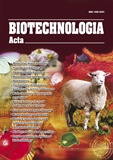ISSN 2410-7751 (Print)
ISSN 2410-776X (Online)

Biotechnologia Acta Т. 17, No. 3, 2024
P. 59-65, Bibliography 16, Engl.
UDC: 577.218+616-006
doi: https://doi.org/10.15407/biotech17.03.059
Full text: (PDF, in English)
GENERATION AND CHARACTERIZATION OF POLYCLONAL ANTIBODIES SPECIFIC TO HUMAN ESTROGEN RECEPTOR ERα
Institute of Molecular Biology and Genetics of the Natonal Acvademy of Scienes of Ukraine, Kyiv
Aim. The purpose of the study was to generate and characterize anti-hERα polyclonal antibodies for elucidation of functional relationships between isoforms of estrogen receptor ERα and isoforms of ribosomal protein S6 kinase — S6K1.
Methods. cDNA cloning. Expression of recombinant proteins in bacterial system. Affinity purification of His-tag fused recombinant proteins using Ni-NTA chromatography from bacterial lysates. Generation of polyclonal sera by mice immunization. Western blot analysis and immunoprecipitation.
Results. cDNA coding for full-length hERα was cloned into expression vector pET28a in frame with His-tag sequence. Recombinant hERα-His protein was expressed in E.Coli and purified by Ni-NTA chromatography. Purified hERα-His was used as an antigen for mice immunization and generation of polyclonal antibodies. The specificity of polyclonal antibodies was analyzed by Western blot and immunoprecipitation of hERα from MCf-7 cell lysates.
Conclusions. Generated anti-hERα polyclonal antibodies are of conformational type since they specifically recognized hERα only in immunoprecipitation but not in Western blot. Created polyclonal antibodies a suitable for the detection and analysis of hERα protein complexes.
Key words: human estrogen receptor α (ERα), cloning, expression of recombinant proteins, antibodies, immunoprecipitation.
© Palladin Institute of Biochemistry of the National Academy of Sciences of Ukraine, 2024
Refrernces
1. Siegel R., Ma J., Zou Z, Jemal A. Cancer statistics. CA Cancer J. Clin. 2014, 64: 9‑29. https://doi.org/10.3322/caac.21208
2. Francis I. M., Altemaimi R. A., Al-Ayadhy B. Alath P., Jaragh M., Mothafar F. J., Kapila K. Hormone Receptors and Human Epidermal Growth Factor (HER2) Expression in Fine-Needle Aspirates from Metastatic Breast Carcinoma – Role in Patient Management. Journal of Cytology, 2019, 36(2): 94-100. https://doi.org/10.4103/JOC.JOC_117_18.
3. Harvey J. M., Clark G. M., Osborne C.K., Allred D. C. Estrogen receptor status by immunohistochemistry is superior to the 1999 ligand-binding assay for predicting. J Clin Oncol. 1999, 17(5): 1474-81, https://doi.org/10.1200/JCO..17.5.1474.
4. Bernstein L., Lacey J. V., Jr. J. Receptors, Associations, and Risk Factor Differences by Breast Cancer Subtypes: Positive or Negative? Natl Cancer Inst. 2011, 103: 451–453. https://doi.org/10.1093/jnci/djr046
5. Habara M., Shimada M. Estrogen receptor α revised: Expression, structure, function, and stability. Bioessays, 2022, 44(12): e2200148.2022, https://doi.org/10.1002/bies.202200148.
6. He Y., Sun M. M., Zhang G.G., Yang J., Chen K.S., Xu W.W., Li B. Targeting PI3K/Akt signal transduction for cancer therapy. Signal Transduct Target Ther. 2021, 6: 425. https://doi.org/10.1038/s41392-021-00828-5
7. Khatpe A. S., Adebayo A. K., Herodotou C. A., Kumar B., Nakshatri H. Nexus between PI3K/AKT and Estrogen Receptor Signaling in Breast Cancer. Cancers, 2021, 13: 369. https://doi.org/10.3390/cancers13030369
8. Strillacci A., Sansone P., Rajasekhar V.K., Turkekul M., Boyko V., Meng F., Loomis B.Н., Brown D., Berger M.F., Hendrickson R.C., Chang Q., Stanchina E., Pareja F., Filho J.S.R., Rajappachetty R.S., Priore I., Liu B., Cai Y., Penson A., Mastroleo C., Berishaj M., Borsetti F., Spisni E., Lyden D. ERα-LBD, an isoform of estrogen receptor alpha, promotes breast cancer proliferation and endocrine resistance. npj Breast Cancer, 2022, 8, 96. https://doi.org/10.1038/s41523-022-00470-6.
9. Filonenko V.V., Tytarenko R., Azatjan S.K., Savinska L.O., Gaydar Y.A., Gout I.T., Usenko V.S., Lyzogubov V.V. Immunohistochemical analysis of S6K1 and S6K2 localization in human breast tumors. Exp Oncol. 2004, 26(4): 294–299. https://pubmed.ncbi.nlm.nih.gov/15627062/
10. Lyzogubov V., Khozhaenko Y., Usenko V., Antonjuk S., Ovcharenko G., Tykhonkova I., Filonenko V. Immunohistochemical analysis of Ki-67, PCNA and S6K1/2 expression in human breast cancer. Exp Oncol. 2005, 27(2): 141–144. https://europepmc.org/article/med/15995633.
11. van der Hage J. A, van den Broek L. J, Legrand C., Clahsen P. C., Bosch C. J. A., Robanus-Maandag E. C., van de Velde C. J. H. and van de Vijver M. J. Overexpression of P70 S6 kinase protein is associated with increased risk of locoregional recurrence in node-negative premenopausal early breast cancer patients. Br J Cancer. 2004, 90(8): 1543–50. https://doi.org/10.1038/sj.bjc.6601741.
12. Rachel L Yamnik, Alla Digilova, Daphne C Davis, Z Nilly Brodt, Christopher J Murphy, Marina K Holz. S6 Kinase 1 Regulates Estrogen Receptor — in Control of Breast Cancer Cell Proliferation. J Biol Chem. 2009, 6, 284(10): 6361-6369. https://doi.org/10.1074/jbc.M807532200
13. Zaiets I.V, Sivchenko A.S, Khoruzhenko A.I, Savinska L.O., Filonenko V.V. The р60-S6K1 isoform of ribosomal protein S6 kinase 1 is a product of alternative mRNA translation. Ukr. Biochem. J. 2018, 90(4): 25–35. https://doi.org/https://doi.org/10.15407/ubj90.04.025.
14. Zaiets I.V, Holiar V.V, Sivchenko A.S, Smialkovska V.V., Filonenko V.V. p60-S6K1 represents a novel kinase active isoform with the mode of regulation distinct from p70/p85-S6K1 isoforms. Ukr. Biochem. J. 2019, 91(4): 17–25. https://doi.org/https://doi.org/10.15407/ubj91.04.017.
15. Zaiets I. V., Holiar V. V., Filonenko V. V. Identification of a novel S6K1 splice variant coding for the p60-S6K1 isoform. Biopolymers and Cell. 2019, 35(2): 99–106. doi: http://dx.doi.org/10.7124/bc.00099B.
16. Garifulin O. M., Zaiets I. V., Kosach V. R., Horak I., Khoruzhenko A., Gotsulyak N.Ya., Savinska L.O., Kroupskaya I., Martsynyuk M.Ye., Drobot L.B., Filonenko V.V. Alterations in S6K1 isoforms expression induce Epithelial to Mesenchymal Transition and Estrogen Receptor 1 Silencing in human breast adenocarcinoma MCF-7 cells. Biopolymers and Cell. 2023, 39(3): 189-200. http://dx.doi.org/10.7124/bc.000A9D.

